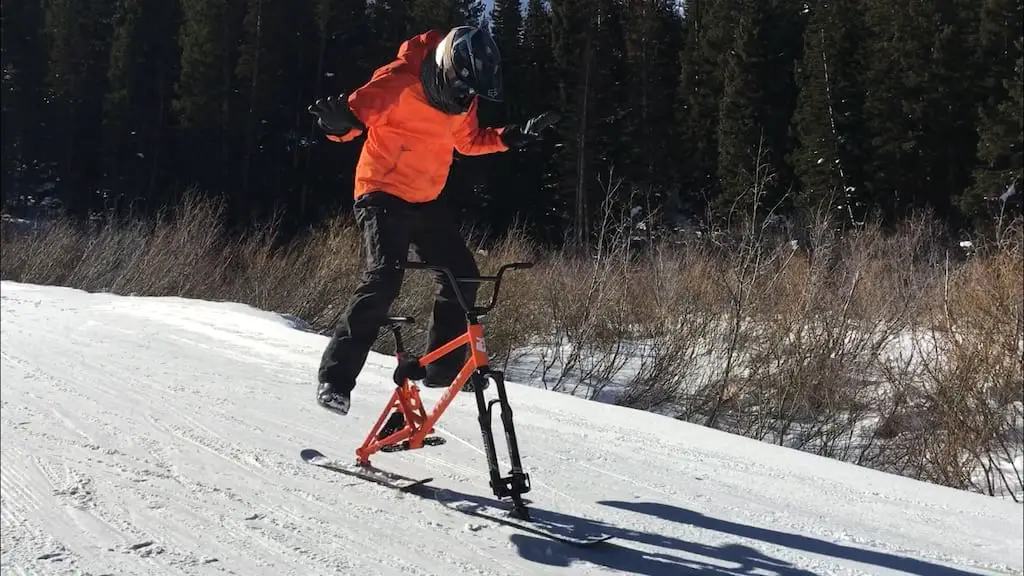Are you a cyclist looking to quickly pick up a winter sport or have another one that builds on your cycling technical abilities?
The Ultimate Crossover Sport?
I had the opportunity to spend the day with the foremost ski bike program operating in the US and I can tell you, as a MTBer, that you will immediately enjoy yourself. Ski biking, Cf. skibobbing (involving the addition of foot skis), has been an activity in the US for nearly 20 years, but only more recently, with the development of reliable and mass produced equipment, has it started to become popularly accepted. I first encountered ski biking about 10 years ago through Matt Beringer, a BMX pro, who really pushed progression of equipment and riding style back when only a handful of resorts across the US were allowing the activity. Matt let me take one for a ride and I could easily see the appeal even if I couldn’t stop.
Flash forward ten years and I still can’t stop, but I’m with Mark Kugel and TNGNT ski bikes at Brighton Resort getting instruction and learning about the latest in ski bike tech. While a number ‘shed builders,’ MTB builders (Koski!) and snow sports companies (Ortlieb) have attempted to develop the US market, only two, Lenz Sport and TNGNT, are manufacturing at any scale. Lenz, starting as an aluminium metal fab and MTB builder, has been making their ski bikes for about 10 years and they can be credited with bringing MTB technology, including rear suspension to the masses. TNGNT has taken it one step further by offering an off-shore produced frame combined with off the shelf MTB suspension to produce full-featured, affordable ski bikes starting at $1500.00.
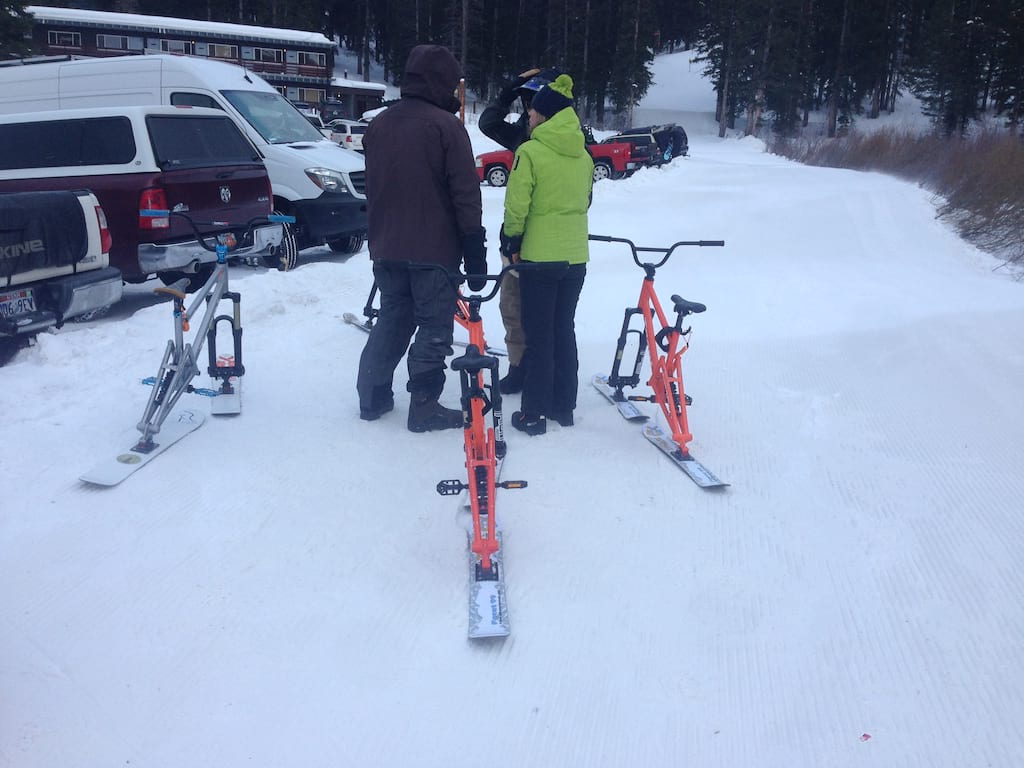
Looking at the ski bike, you can see that the frame relies on a UK-familiar, single pivot design driving a coil shock for about 6 inches of rear travel at the rear ski mount. Because of a lack of drivetrain or braking forces in ski bikes, the single pivot design has become the dominant suspension layout, though the designs have not yet developed into rocker actuated shocks, with their controlled progression. The coil is a bit surprising given it’s lack of rider-weight adjustment and the lowered heat management requirements with a winter sport. But, TNGNT claims the coils have superior suppleness, a linear spring rate that plays well with the single pivot (or, it would want that rocker) and has high reliability. Besides, coils are widely available and cheap, once you figure out the spring weight that you need.
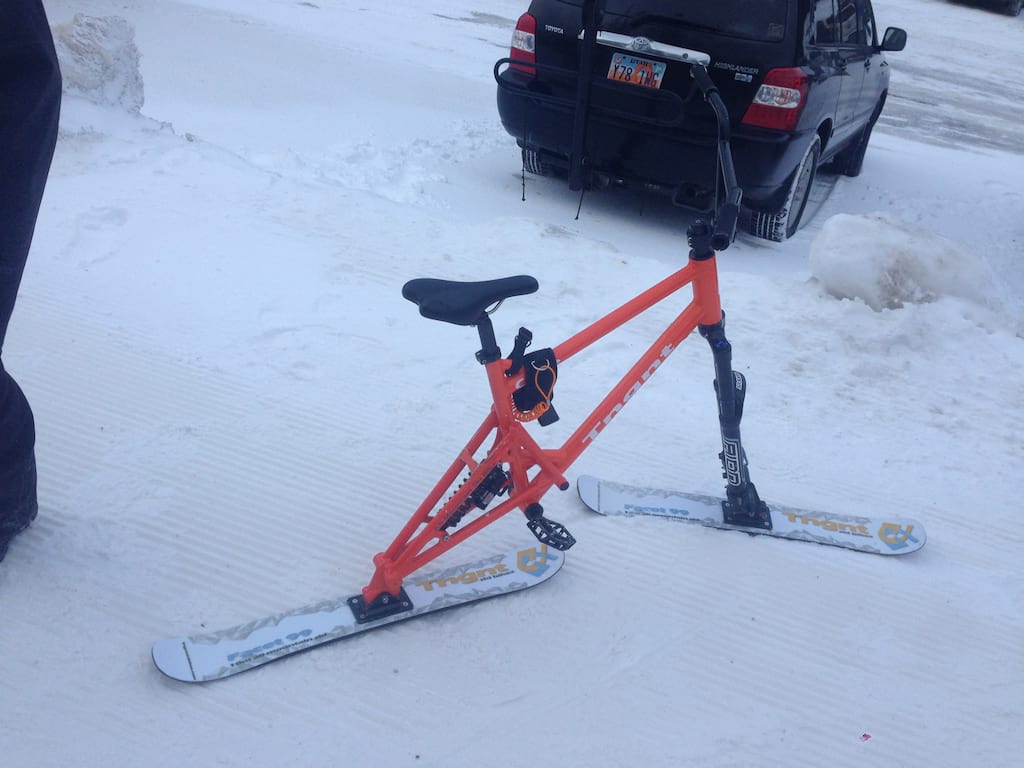
Other elements of the bike are MTBy: the fork is a single crown, though some bikes have dual crowns (and more travel); the headtube/steering axis angle has essentially the same effect as on a bike; the bmx bars raise the grip position of the very low frame and lack of half a wheel height to a comparable MTB descending (standing) position. About that standing position: I found it a little disconcerting to have the stance so narrow, much narrower than I would naturally ski, with just about 110mm between the feet. And, why do the pedals spin? I’m not really sure, though that was a non-issue coming from a MTB trick background, as you can see.

The other element unique to ski bikes is the ski mount, which TNGNT calls the SRS, a patented foot, bumper and cradle that dampen the bike ski interface and provide return-to-center (flat) action as the ski tracks terrain variation and gets air. Other companies use other systems such bungees to provide similar function but, Kugel claims the bumper, aka Skiblox, are analogous to tires in that inflation can be varied by choosing a block of a different durometer (hardness), with four variations available.
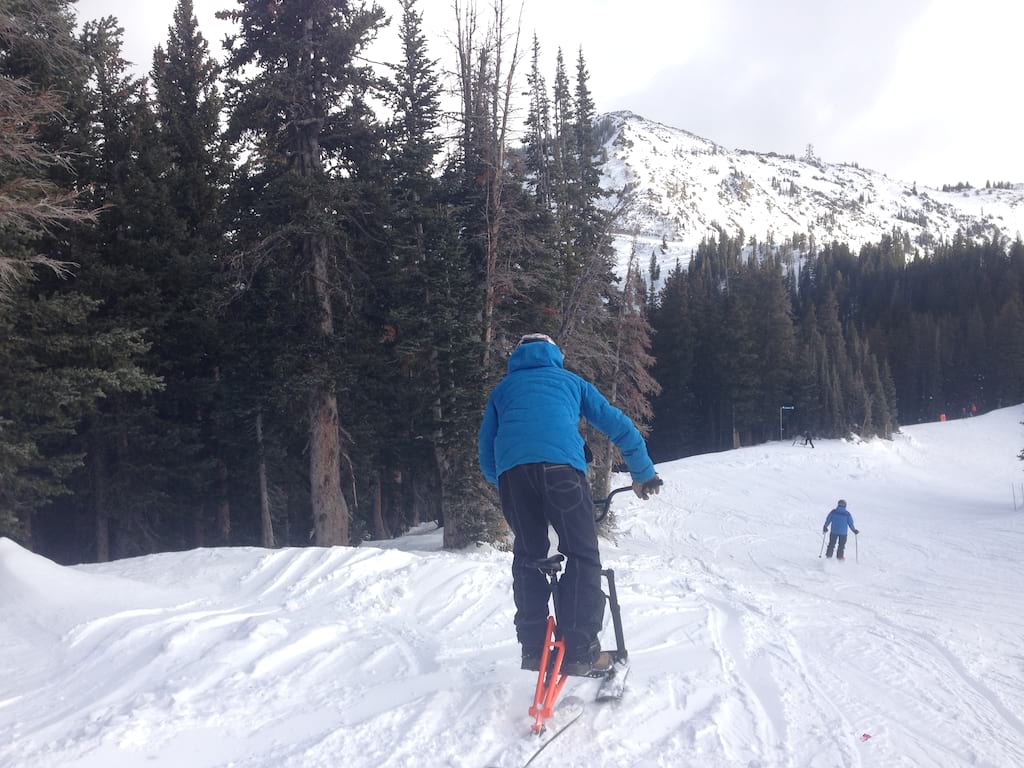
The frame and forks typically mount via a dummy axle system with 15mm the most common up front, to which TNGNT adds a fork leg clamp, increasing the rigidity of the system. Of course, the skis are exchangeable, by remounting the cradles to ones of different widths, profiles and cambers, all of which have similar effects to the same shapes in skis, e.g. a fatter ski is better for bigger folks and deeper snow. Of course, one thing that can’t be changed much is length, which hovers around 200 cm in order to provide the front-back ski gap while (approximately) center mounting the skis for control. It seems common for riders to experiment with chopped down alpine skis, especially fat ones and up front as a means to have proper flotation when the snow is deep.
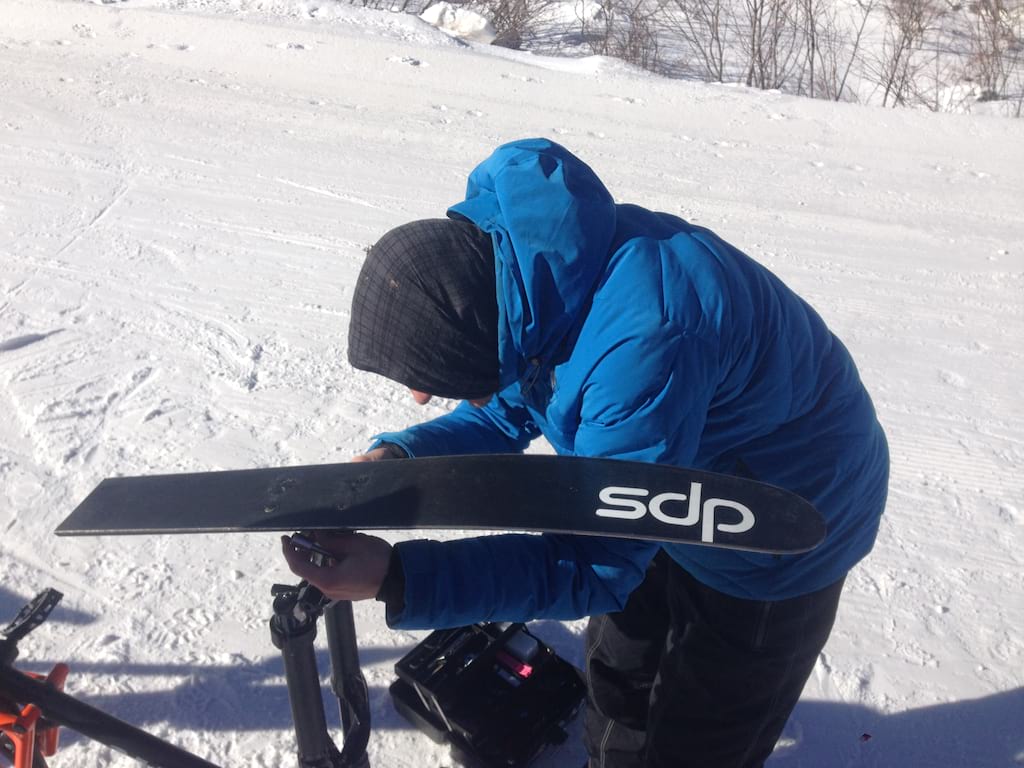
So, how is it to actually use this? Is it anything like MTB? There are two skills to master immediately, how to get on the chair lift and how to stop. With no brake at hand (oh, I reached for it), variations of the hockey stop are required. The most important of which is the foot-down, flat-out style of a dirt track racer, useful when learning and in any emergency, but can result in a tumble. Otherwise, it’s keeping your feet up and leaning while swinging the bike hard around with your hips. There is no real bar turning with the hockey stop, you are trying to keep the skis inline and on edge. While that method doesn’t come without some practice, the loading of ski bikes on chair lifts is pretty basic, once you know the sequence. It starts by hooking the bike seat (which is usually positioned for this height) onto the edge of the chair, then rotating the bike back, adjacent to you, such that the handlebars then hang on the back of the chair.
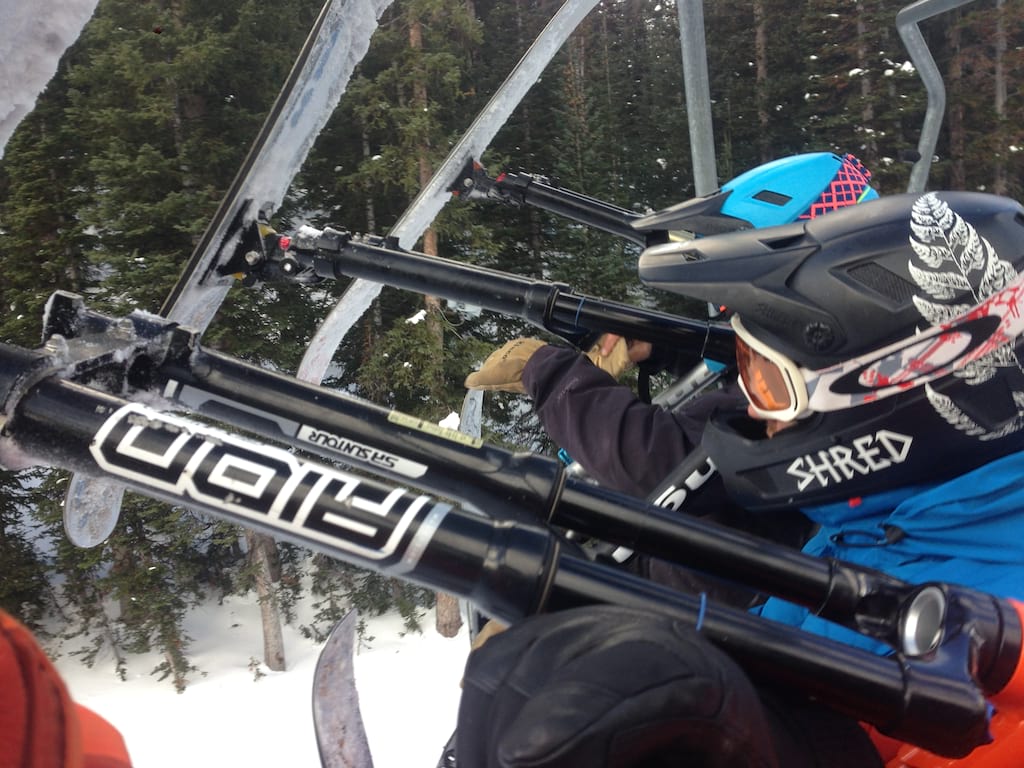
In order to exit the chair, you simply reverse the bike tilt process, hanging it by the seat just prior to disembarking, and walk off the deck with the bike. At this point most riders remove the “required” safety leash (they don’t go anywhere when not upright and are easy to find, even in deep snow) and push off, often in a seated position, until arriving at a particular run. I found the seated position less controllable but, useful in flat areas (more aero), when the legs were tired and around others for whom my 190cm standing 25cm off the ground is a little imposing. In the sitting position, turning is largely initiated and created by the handlebar input. Conversely, once I was on anything steeper than about 5*, I really needed to be standing in order to control speed.
When standing, turns are initiated either through the handlebar or with the hips and legs, or both and can include counter-steer techniques, especially on steeper terrain. This venture was my third time on a ski bike and the first time that I had gotten more than 2 runs, so I would say that an MTB background is very helpful but, so is a ski or snowboard background. Have a mix of those, all the better, because unlike MTB the ski bike is almost always in a skidding turn, never really hooked up, catch my drift? So, I found my ski and snowboard anticipation (what is this skidding arc going to look like) and turning style to be useful, particularly around others and in trees. On the other hand, the stance was very MTB making terrain reading, jumping and rolling steeps, very familiar. I can pretty confidently say that if you are a regular MTBer, it should be possible to be riding (and probably some crashing) on blues/intermediate the first day. While not my first day, I was able to ride black/expert runs successfully but, I think I owe much of that to having an instructor with me to steepen and shorten the learning curve. Your results may vary, but I’m pretty sure you’ll pick it up quickly and it will make you smile, want to ride your wheeled bike and improve your riding.
Need to know
What else do you need to know? There are European and American ski bike groups (A U.K. one, too, that seems skibob focused) that maintain registries of ski areas that support ski biking, rentals and festivals. You’ll need the same type of winter garb as you would skiing or snowboarding, but definitely wear kneepads and a fullface (see what I did there?). There’s broad variation footwear, but some sort of insulated high-top is required. I chose snowboard boots, but will use 5.10 light hikers (Camp IVs) or a waterproof insulated snow boot, next time, for a little more ankle flex. Finally, you’re probably not going to succeed as a freak and without some instruction or a posse, so bring along some friends (or pay for a pro), just being able to see other’s technique (and struggle) makes your day a lot more fun.
